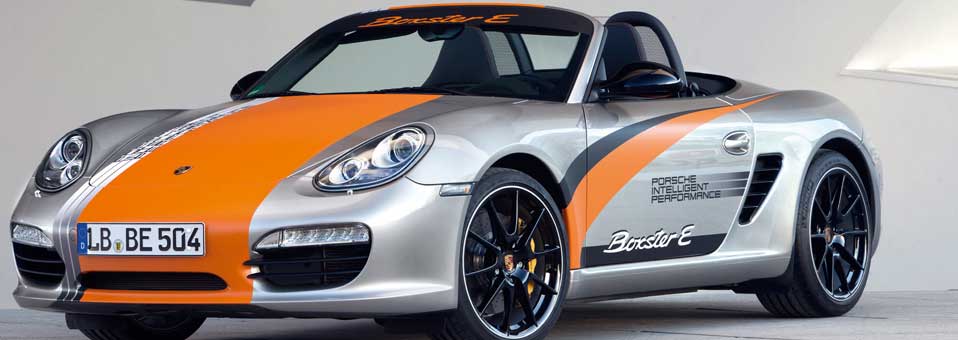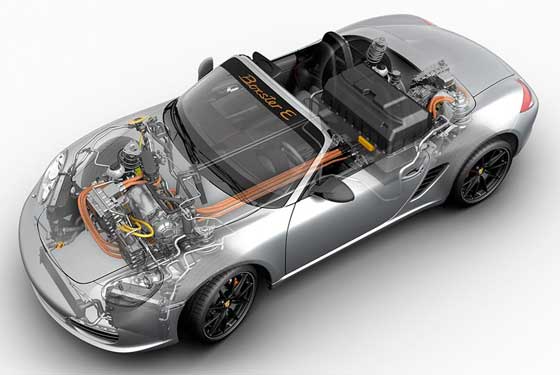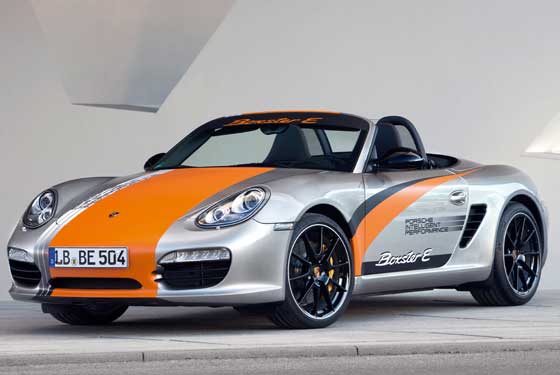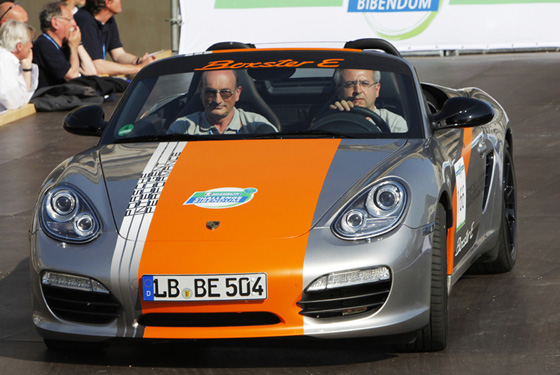Electric-powered rear and four wheel-drive variants of the Porsche Boxster E roadster sparked interest last week at the Michelin Challenge Bibendum in Berlin.
- Prototype electric Porsche Boxster E fascinates at the Michelin Challenge Bibendum in Berlin
- 1,600 kg and 0-62mph in 5.5 seconds – Porsche driving dynamics and performance at the heart of Boxster E project
- Active Sound Design being tested to alert pedestrians of vehicle’s proximity
Porsche was demonstrating its Boxster E prototypes to a wide audience of representatives from politics, industry, trade and research at this global forum for sustainable mobility in the German capital. Around a sporting circuit, the Porsche showcased the Boxster E sports car concept; exhibiting the combination of innovation, performance and chassis responsiveness that is characteristic of the marque, and follows similar ground-breaking initiatives; the 911 GT3 R Hybrid race car, 918 Spyder super sports car and 918 RSR concept.
The Boxster E prototypes are being used as part of the “Model Region Electro-Mobility Stuttgart” 1 large-scale trial to explore the everyday practicality of all-electric vehicles and how they are used, especially in terms of driving and battery charging. What the researchers at Porsche are looking for is an understanding of the requirements that will shape tomorrow’s products, the future direction of Porsche Intelligent Performance and how to integrate electric vehicles into the infrastructure.
Mid-engine design provides perfect foundations
Thanks to its design as a mid-engine sports car, the Porsche Boxster is the ideal vehicle platform for conducting realistic trials with electric-drive systems. The open-top two-seater car is very light, enabling the new components that are the electric motor, battery and high-voltage technology to be accommodated within the vehicle in a crash-proof way. Together with the low drag, this reduces driving resistance for optimal range. Also of importance for a Porsche sports car, even one that is electrically-driven, is the high driving dynamics potential, not least as a consequence of the balanced axle-load distribution intrinsic to the mid-engine design.
Boxster E with four wheel-drive
The Boxster E is an all-electric vehicle without any additional combustion engine on board. Propulsion is provided by two independent electric motors with constant mesh gearboxes that act on the front and rear axles. The rear drive unit comprising motor and transmission, together with the power electronics for controlling the electric motor is located where the manual transmission and exhaust system are accommodated in the conventional Boxster. In the front end, the space vacated by the 64-litre fuel tank, now redundant, is occupied by the second drive unit. The power electronics unit in the adjacent luggage compartment serves the front axle electric motor. The Boxster E thereby features all-wheel drive without mechanical transmission of power. To ensure maximum driving stability and traction, a central electric control unit looks after the synchronisation of the two electric motors and controls the drive torque distribution to the front and rear axle.
The two electric motors develop a total power output of 180 kW and a maximum total torque of 540 Nm at a maximum engine speed of approximately 12,000 rpm. That means that the two electric motors in tandem deliver significantly higher drive power than what is available from present day hybrid vehicle electric power units. As well as the all-electric drive of the Boxster E producing zero tailpipe emissions, it also offers a completely new form of Porsche driving pleasure. Maximum torque of the electric drive kicks in virtually from the first turn of the engine. The Boxster E moves almost silently while at the same time developing powerful propulsion from the very outset.
The two motors enable the two-seater to sprint to 100 km/h (62 mph) in 5.5 seconds from a standing start. Its top speed, limited to 200 km/h (124 mph) is achieved without any gear change at all – whether automatic or manual. The high power output of the two motors offers a second advantage: it means more recovered power is available because more energy can be recovered during braking. This increases efficiency of the drive unit.
Boxster E with rear wheel drive
In the case of the two other Boxster E models with rear wheel drive there is no front electric motor, therefore delivering a power output of 90 kW and a rated torque of 270 Nm. This model can sprint from a standing start to 100 km/h (62 mph) in 9.8 seconds, with a top speed of 150 km/h (93 mph).
Active Sound Design
As all Boxster E models are comparatively quiet on the road, Porsche engineers have designed an Active Sound Design system that provides drivers with acoustic feedback as well as alerting pedestrians and other road users.
A new expression of Porsche Intelligent Performance
Irrespective of variant, the heart of every Boxster E is manufactured by Porsche. The lithium-iron-phosphate based traction battery is fitted in place of the combustion engine. Each of its cells has a nominal voltage of 3.3 V and an individual capacity of 20 Ah. Based on the NEDC, the combined energy from 440 individual cells is good for approximately 170 kilometres (107 miles) of driving in the Boxster E with its ready-for-the-road weight of a mere 1,600 kg.
For an overall weight of 341 kg, the battery’s energy content is 29 kWh of which for inherent physical reasons approximately 26 kWh are available for use – an outstanding performance for a battery.
Its maximum power output is 240 kW, or 60 kilowatts more than the all wheel-drive Boxster E draws under full load. The battery and power unit components are connected to two water cooling circuits. As with the conventional power unit, the heat exchangers are accommodated behind the front air intakes.
The battery is anchored to the same points on the body structure as the combustion engine in the Boxster S. There are numerous advantages to this, especially in the event of a crash, because by using the same load paths as in the Boxster S, the battery is optimally retained within the vehicle while at the same time being protected from damage by the surrounding body structure thanks to its central position within the vehicle. As with the combustion engine in the production car, the traction battery is installed in the Boxster E from below and can be swapped out very quickly if so required. This is also facilitated by special motor sport fasteners that enable the battery to be disconnected from the cooling circuit without air getting into the system.
Charging the Boxster E
The traction battery is charged via a charging cable. Any conventional socket can be used as an energy source. The charging port on the vehicle features an illuminated ring and, as with any Porsche sports car, the vehicle is ‘refuelled’ (in this case, recharged) at the front end. The charger is accommodated at the front of the car. It converts alternating current from the socket into direct current, enabling the traction battery to store the electric energy. Its charging capacity is a maximum of 3.3 kW meaning that it takes approximately nine hours for a full charge. The charging time can however be reduced using a rapid charging function. There is enough space left over for luggage in the front storage compartment despite the electronic components; the rear luggage compartment of the Boxster E remains unchanged.
Behind the wheel
It goes without saying that all of the important safety and comfort features of the production model are replicated in the Boxster E. The new brake system enables an optimal melding of the braking forces of the electrical generators and the mechanical brake system, delivered via lightweight Porsche Ceramic Composite Brakes (PCCB). The electrically-powered air conditioning compressor accommodated in the front luggage compartment ensures comfortable temperatures inside the vehicle.
Not only are the clutch pedal and gearshift lever absent in the Boxster E, there is no rev counter either. In its place is a special ‘E-Power meter’ in the central instrument cluster display. A swing to the right indicates power call-off, and to the left, power recovery. Recuperation – namely the recovery of energy by using the electric motors as generators – can be modified by means of the push buttons in the steering wheel; the effect is akin to an on-demand engine brake. Otherwise, when the driver lifts his foot off the accelerator, the Boxster E simply sails on, using the moving vehicle’s kinetic energy. Among its other functions, the instrument cluster’s right-hand TFT display acts as an intelligent range management system, displaying useful driving information: the range remaining or how many miles can be gained by switching off the air conditioning system.



